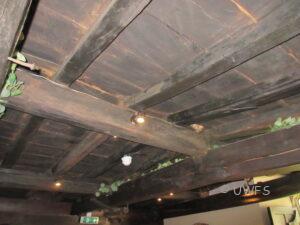
Belvedere and Priests House. Photo Phyllida Oates
Barden Tower, the Priest’s House and Chapel are so familiar to those of us who live near Skipton we would drive past the historic site almost without paying it any attention. It certainly is more prominently in view when approached from the south, the Strid and Bolton Abbey. But this visit, in the long sunshine of a late summer’s day, made a noticeable impression on our group. Due to unforeseen circumstances this change of plan was organised by Peter and Peggy at very short notice, and much appreciated. We met at the 17th century Barden Bridge, which has a considerable number of masons’ marks under the arches and which has withstood the force of storm waters all these centuries. There was inconclusive discussion on where the ford may have been, or even the site of an earlier bridge, before we moved uphill to Barden Tower.
Although sadly ruinous now, the effect of the imposing structure of Barden Tower presented a newly absorbing interest to our group. The day was very quiet, with no breeze, very atmospheric, and the knowledge we were looking at such a scene of centuries of historic drama was completely understood.

Medieval presence. Photo Phyllida Oates
When William the Conqueror was establishing his authority over our Island, one of his awards was
the Honour of Skipton to the Norman lord, Robert de Romille, which included the vast Forest of Barden. Romille built the original Skipton Castle in 1090, a motte and bailey castle, and established six forester lodges within Barden Forest, one of which was Barden ‘Tower’, which were presumably wood and thatch structures at that time. Five of the Lodges were mainly small farms or vaccaries, but the ‘Tower’ was used to hold Forest Courts and administer local justice, and also as a refuge in the 14th century during the raids of the Scots.
In 1310 Edward II was king, and he appointed Robert de Clifford (1st Lord Clifford) the Honour of Skipton, and as Guardian of Craven. Barden Tower continued as before within the estate but also became the residence for the Cliffords and guests during the hunting of deer and wild boar through the forest.

Belvedere entrance. Photo Phyllida Oates

Within Barden Chapel. Photo Phyllida Oates
The 15th century Wars of the Roses claimed the lives of Thomas Clifford (8th Lord) and his son John (‘Butcher’ Clifford), supporters of Lancastrians. During this time John’s son, Henry, was hidden in a remote farming community in Cumbria or Westmorland, for the safety of a surviving Clifford. With the disastrous result for the Lancastrian cause at Towton, the Cliffords were stripped of their lands and Skipton Castle. King Henry VI was deposed and the throne seized by the Yorkist Edward IV. Edward’s brother, Richard, Duke of Gloucester, did later capture the throne for himself, as Richard III, following his occupation of Skipton Castle and the estates.
When Richard III was killed at the Battle of Bosworth in 1485, the Houses of Lancaster and York had been wiped out and the Welsh emerged as the real victors of the Wars of the Roses, placing Henry Tudor (Henry VII) on the throne, and the Cliffords regained their lands and Skipton Castle.

Oak Room ceiling. Photo Phyllida Oates

Roof of Oak Room. Photo Phyllida Oates
Henry Clifford, (10th Lord Clifford, nicknamed the ‘shepherd lord’) established some stability in Barden Forest, rebuilt the Tower in stone and enlarged the structure as a three-storey rectangular tower with a stair turret on the north wall and a projecting rectangular tower on the south wall. A huge window on the south wall opened onto a first-floor Great Hall and overlooked the great park. Henry preferred this as his residence rather than Skipton Castle. At this time, early 16th century and into 17th century, Henry also built the Priest’s House and Chapel, including a small tower rising from the Chapel porch which was known as a banqueting tower/belvedere, and the whole complex was encircled by a curtain wall. The extensive area known as Little Park began to be created, with a kitchen garden, orchards and herb gardens, as well as ornamental gardens. The considerable workforce was accommodated in a camp/quarters, which have been identified as platforms, terraces and hollow ways.

Carved oak spandrels. Photo Phyllida Oates
Barden Tower was attacked and ransacked during the rebellion of the Pilgrimage of Grace in 1536 and then suffered serious damage during the Civil War. Succession had progressed to Lady Anne Clifford (daughter of the 3rd Earl Cumberland) in 1657, and she commissioned extensive repairs and restorations and extensions during the long years of her ownership, although she rarely resided in the Tower. However, this major restoration suffered once again, as Lady Anne’s heirs allowed use of the Tower to lapse. By the end of the 18th century lead was removed from the roof and the roof timbers taken out, leaving the Tower to crumble, and we are left to wonder what the next dramatic episode will be for Barden Tower.……….Through successive marriages between Earls Cumberland, Burlington and Cavendish, the estate of Bolton Abbey and Barden belong now to the Dukes of Devonshire.

View from Howgill Lane. Photo Phyllida Oates
To conclude our visit, we drove along the ancient Howgill Lane with views over the broad landscape, much of which was once dense forest…….and enjoyed our lunch at Brownies cafe.
Phyllida



